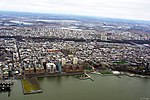Firemen's Monument (Hoboken, New Jersey)
1891 establishments in New Jersey1891 sculpturesBronze sculptures in New JerseyBuildings and structures in Hoboken, New JerseyFirefighting in New Jersey ... and 9 more
Firefighting memorialsMonuments and memorials in New JerseyMonuments and memorials on the National Register of Historic Places in New JerseyNational Register of Historic Places in Hudson County, New JerseyNew Jersey Register of Historic PlacesOutdoor sculptures in New JerseyPublic art in Hudson County, New JerseySculptures of men in New JerseyStatues in New Jersey

The Firemen's Monument is a 28 ft 0 in (8.53 m) tall monument in Hoboken, Hudson County, New Jersey, United States, that was designed by American sculptor Caspar Buberl and completed in 1891. The monument was built to commemorate the Volunteer Fire Department in Church Square Park on May 30, 1891.
Excerpt from the Wikipedia article Firemen's Monument (Hoboken, New Jersey) (License: CC BY-SA 3.0, Authors, Images).Firemen's Monument (Hoboken, New Jersey)
Willow Avenue,
Geographical coordinates (GPS) Address Nearby Places Show on map
Geographical coordinates (GPS)
| Latitude | Longitude |
|---|---|
| N 40.742277777778 ° | E -74.032777777778 ° |
Address
Church Square Park Dog Playpen
Willow Avenue
07030
New Jersey, United States
Open on Google Maps









